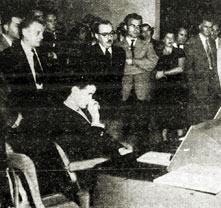Television
-

La Patrie, 6 September 1952, p21
Source : Bibliothèque et Archives nationale du Québec
-

La Patrie, 8 September 1952, p.6
Source : Bibliothèque et Archives nationale du Québec
Early Experiments
When Radio-Canada first began television broadcasts in Montreal on 6 September 1952, television already had a long history. Several key experiments had taken place in the 1920s, when a few inventors around the world were working with mechanical television. In Montreal, the newspaper La Presse and the radio station CKAC were the first, in 1931, to launch a television station using this technology. Even though there were barely more than a score of receivers in the entire country, the station VE9EC broadcast musical programs and a radio play, La paix chez soi, starring Henri Letondal, until 1933. Other broadcasting experiments with mechanical television took place, in particular by the Montreal department store Eaton’s in 1933.
Throughout the 1930s, several inventors and companies worked on an electronic television system using the cathode ray tube. In the United States, RCA launched the new technology and broadcasts for the general public at the World’s Fair in New York in 1939. The Second World War, however, interrupted television’s commercial development in North America.
The Beginnings of a Mass Medium
Things started to take off once the war was over, however. In the United States, the major networks (ABC, NBC, CBS) grew rapidly between 1945 and 1951. The number of American households with a television set went from 10,000 to ten million during this time; it would reach twenty million in 1953 and forty million in 1960. This rapid growth was increasingly regulated by the industry and public institutions. In the last 1940s, North American television manufacturers agreed upon a standard resolution of 625 lines. In the United States, the Television Code, which granted government permits and set frequencies, entered into effect in 1952. At that point, Canada could only follow suit.
The First Canadian Broadcasters
In Canada, the National Film Board and the Canadian Broadcasting Corporation/Société Radio-Canada, a government body created in 1936, vied for responsibility for the first television network at the Massey Commission hearings. In the end, the CBC was given a mandate by the federal government to develop the first Canadian television network, although it had to set aside some programming time for the NFB. Radio-Canada finally went on air in Montreal on 6 September 1952, and the CBC followed suit in Toronto two days later.
Over the next few years, the percentage of households in Quebec with a television set increased rapidly, from 9.7% in 1953 to 38.6% in 1955 and 88.8% in 1960, even though in its early years the Montreal station CBFT broadcast only a few hours of bilingual programming daily. Radio-Canada, meanwhile, broadcast many French films, which it acquired from France-Film.
In 1958, federal legislation opening the door to private broadcasters was adopted. Two years later, Paul L’Anglais and J.A. DeSève founded Télé-Métropole, which soon became known as “channel 10”. Télé-Métropole grew into a network with access to 94% of the Quebec market by 1977.
Radio, Cinema and Television
Television’s arrival put a damper on the growth of the film industry in Quebec. In addition to being largely responsible for the drop in cinema attendance in the years following Radio-Canada’s arrival on the airwaves, television scooped up most of the talent working in Quebec film between 1944 and 1952. This phenomenon affected everyone from technicians to actors and from writers to directors. Television also laid its hands on many stories that had seen great success in radio and film, such as Claude-Henri Grignon’s Un homme et son péché, which was adapted to the small screen under the title Les belles histoires des pays d’en-haut.
At the same time, television created new outlets for small producers of independent films, such as Oméga Productions, a company founded by Roger Racine and two former employees of Associated Screen News, Pierre Harwood and Henri Michaud.
Duplessis and Television
In the years preceding television’s arrival in Quebec, Maurice Duplessis had accused the National Film Board and a few radio stations of interfering in provincial life. This story played out again when the federal government created Radio-Canada’s television service. Accusing state television of having a centralising influence, Duplessis initially blocked the construction of transmitters on Mont Royal by refusing to issue the necessary permits. He then tried to subject state television to provincial censorship by modifying censorship legislation in December 1952. The new law, however, had no effect, as Radio-Canada refused to recognise the provincial government’s jurisdiction. The relevant article was finally stricken from cinema legislation in 1967.